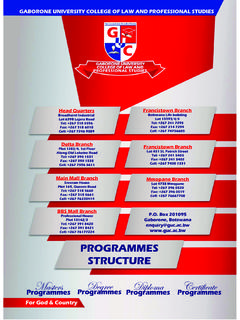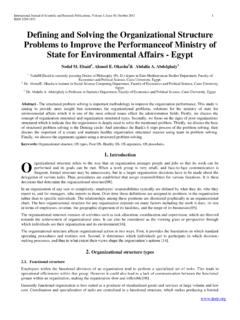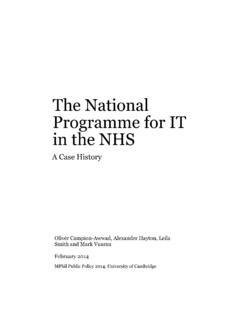Transcription of 2018 Erasmus+ Programme Guide v1 - European Commission
1 Erasmus+. Programme Guide In the case of conflicting meanings between language versions, the English version prevails. Version 1 (2018): 25/10/2017. 1. Table of contents ABBREVIATIONS .. 3. INTRODUCTION .. 4. How to read the Programme Guide .. 4. PART A - GENERAL INFORMATION ABOUT THE ERASMUS+ Programme .. 5. What are the objectives and important features of the Erasmus+ Programme ? .. 7. General Objective .. 7. Important features of the Erasmus+ Programme .. 7. What is the structure of the Erasmus+ Programme ? .. 11. Key Action 1 Mobility of individuals .. 11. Key Action 2 Cooperation for innovation and the exchange of good practices.
2 11. Key Action 3 Support for policy reform .. 11. Jean Monnet Activities .. 12. Sport .. 12. What is the budget? .. 13. Who implements the Erasmus+ Programme ? .. 14. The European Commission .. 14. The National Agencies .. 14. What other bodies are involved in the implementation of the Programme ? .. 15. Who can participate in the Erasmus+ Programme ? .. 20. Participants .. 20. Participating organisations .. 20. Eligible 21. PART B INFORMATION ABOUT THE ACTIONS COVERED BY THIS Guide .. 24. Education and Training .. 25. Which Actions are supported? .. 25. What are the aims of these Actions? .. 25. 26. Which Actions are supported?
3 26. What are the aims of these Actions? .. 26. Three Key Actions .. 27. Key Action 1: Learning Mobility of Individuals .. 28. Mobility project for higher education students and staff .. 32. Mobility project for VET learners and staff .. 49. Mobility project for school education staff .. 61. Mobility project for adult education staff .. 68. Mobility project for young people and youth workers .. 75. Erasmus Mundus Joint Master Degrees .. 94. Erasmus+ Master Loans .. 102. Key Action 2: Cooperation for innovation and the exchange of good practices .. 103. Strategic Partnerships in the field of education, training and youth.
4 105. Knowledge Alliances .. 127. Sector Skills Alliances .. 136. Capacity Building in the field of higher education .. 156. Capacity Building in the field of youth .. 170. Key Action 3: Support for policy reform .. 187. Structured Dialogue: meetings between young people and decision-makers in the field of 189. Jean Monnet Activities .. 196. Which Actions are supported? .. 196. What are the aims of Jean Monnet? .. 196. Jean Monnet Modules .. 198. Jean Monnet Chairs .. 202. Jean Monnet Centres of Excellence .. 206. Jean Monnet support to associations .. 210. Jean Monnet Networks (policy debate with the academic world).
5 214. Jean Monnet Projects (policy debate with the academic world) .. 218. 1. Jean Monnet unit costs .. 222. Sport .. 226. Which Actions are supported? .. 226. Collaborative Partnerships .. 227. Small Collaborative Partnerships .. 235. Not-for-profit European sport events .. 240. PART C - INFORMATION FOR APPLICANTS .. 244. What to do in order to submit an Erasmus+ Application? .. 244. Step 1: Register in the Participant Portal .. 244. Step 2: Check the compliance with the Programme criteria .. 245. Step 3: Check the financial conditions .. 249. Step 4: Fill in and submit the application form .. 252. What happens once the application is submitted?
6 254. The evaluation procedure .. 254. Final decision .. 254. Notification of grant award decisions .. 255. What happens when the application is approved? .. 255. Grant agreement/decision .. 255. Grant amount .. 255. Payment procedures .. 256. Project life-cycle deadlines and payment modalities .. 257. Other important contractual provisions .. 259. Financial guarantee .. 259. Sub-contracting and award of procurement contract .. 259. Information on the grants awarded .. 259. Publicity .. 260. Checks and 260. Data protection .. 260. Open Access Requirement .. 261. Open Licence and Intellectual property rights .. 261.
7 Rules applicable .. 262. ANNEX 263. Mobility project for higher education students and staff .. 264. Mobility project for VET learners and staff .. 270. Mobility project for school education staff .. 275. Mobility project for adult education staff .. 278. Mobility project for young people and youth workers .. 280. Erasmus Mundus Joint Master Degrees .. 286. Strategic Partnerships .. 289. Capacity Building in the field of higher education .. 301. ANNEX II DISSEMINATION AND EXPLOITATION OF RESULTS .. 307. Introduction .. 307. ANNEX III GLOSSARY OF TERMS .. 313. ANNEX IV - USEFUL REFERENCES AND CONTACT 322. 2. ABBREVIATIONS.
8 DG EAC: Directorate General for Education, Youth, Sport and Culture EACEA: Educational, Audiovisual & Culture Executive Agency ECAS: European Commission Authentication System ECHE: Erasmus Charter for Higher Education ECTS: European Credit Transfer and Accumulation System ECVET: European Credit System for Vocational Education and Training EHEA: European Higher Education Area EIB: European Investment Bank ELL: European Language Label EP: European Parliament EPALE: Electronic Platform for Adult Learning in Europe EQAR: European Quality Assurance Register EQAVET: European Quality Assurance in Vocational Education and Training EQF: European Qualifications Framework ESCO: European Skills, Competences, Qualifications & Occupations EU: European Union FR: Financial Regulation HEI: Higher education institution HERE: Higher Education Reform Experts ICT: Information and Communication Technology ISP: Intensive Study Programme EMJMD: Erasmus Mundus Joint Master Degree NA: National Agency NARIC: National Academic Recognition Information Centre NEO: National Erasmus+ Office NQF: National Qualifications Framework OECD: Organisation of Economic Cooperation and Development OER.
9 Open Educational Resources OMC: Open Method of Coordination PIC: Participant Identification Code URF: Unique Registration Facility VET: Vocational Education and Training 3. INTRODUCTION. This Programme Guide is a tool for anybody who would like to have a thorough knowledge of what the Erasmus+. Programme is about. This document is mainly addressed to those who wish to be: participating organisations: meaning those organisations, institutions, bodies organising activities supported by the Programme ;. participants: meaning those individuals (students, trainees, apprentices, pupils, adult learners, young people, volunteers, or professors, teachers, trainers, youth workers, professionals in the field of education, training, youth and sport, etc.)
10 Involved in activities organised by the participating organisations. Every year, thousands of projects are submitted by organisations across Europe in order to receive financial support from the Erasmus+ Programme ; for this reason, the Commission has set up a transparent evaluation process that aims at providing grants for the best projects: for most Actions, all the rules and conditions for receiving a grant from the Programme are specified in this Programme Guide ;. for some other Actions, which are only mentioned in this Programme Guide , the rules and conditions for receiving a grant are described in specific calls for proposals published by or on behalf of the European Commission .

















